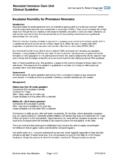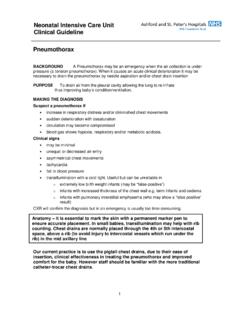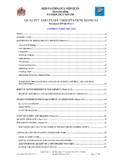Transcription of Transport - Neonatal Transport
1 Neonatal Transport Guideline Amendments Date Page(s) Comments Approved by Dec All Full document review Dr P Reynolds, Chair 2010 Neonatal Clinical Management Group Compiled by: Helen Mayes In Consultation with: Tosin Otunla, Neonatal Transport Consultant Date Issued: 07/02/2008. Review Date: December 2010. Next review date: December 2013. Ratified by: Neonatal Clinical Management Group (Chairman's actions). Date Issued: January 2011. Target Audience: Neonatal Transport Staff Comments on this document to: Helen Mayes ASHFORD & ST. PETER'S HOSPITAL NHS FOUNDATION TRUST. Neonatal Transport Policy See also: NTS working Group: NTS Clinical and Operational Guidelines 2007. Jenkings, K: (2005) NTS Annual report 04-05 . 1. INTRODUCTION. From the beginning of specialised Neonatal Care, there has been a need to Transport babies between hospitals.
2 With the development of regionalised Neonatal Intensive Care, this has further increased, as In-utero transfers are not always feasible, and often specialist services such as surgery are needed. It is recognised that stabilisation of a baby at birth and prior to Transport are key factors in determining the outcome of the baby (NTS Annual Report 2005). With this in mind, a designated Transport service for London and the South east of England was created, to improve Neonatal Care across the region. The teams are divided into London, Kent, Surrey and Sussex, with the Surrey Team being based at St Peter's Hospital. This policy is written both to comply with the requirements of the NICU at St Peter's Hospital (SPH) and also in accordance with the guidelines laid down by the London, Kent Surrey and Sussex Neonatal Transport Service ( LKSS NTS Clinical and Operational Guidelines 2007).
3 Operational hours: Since October 2009, we now run a 24 hour a day, 7 day a week service, running emergency (unplanned) and elective (planned) services in parallel. Emergency services always take priority unless already actively undertaking a planned transfer baby is already in the ambulance. Handover is at either 8am when on nights, to the Lead Team, or at 8pm to the night team. All transfers are to be considered up until 06:30 or 18:30, and all transfers after this time are to be considered on their own merit. This period is discretionary and decisions to accept or refuse calls will be made by the consultant. When the local team is busy, there is cross cover from the London, Kent and Sussex teams which can be accessed via EBS or the teams directly.
4 2. PURPOSE. To ensure appropriate, safe and timely transfer of babies between centres of clinical care To ensure effective communication between all involved in the Transport process. To provide accurate and detailed documentation of Transport activity in line with network and BAPM standards To ensure correct use and maintenance of equipment To maintain high standards of knowledge and skills by provision of training and effective supervision To audit performance and monitor the effectiveness of the service provided 3. DUTIES/RESPONSIBILITIES. DAILY RESPONSIBILITIES OF Transport TEAM. Identify Transport team (doctor, nurse, ambulance personnel). Take handover from the Night Team or from the Lead Team if we are on nights. Transport nurse to liaise with nurse in charge of the shift with regards to potential Transport activity (elective or emergency).
5 Contact Emergency Bed Service (EBS);. Obtain information about any likely transfers Give team's availability status (this should be updated during the course of the shift). Give information about day's planned activity . Phone our network hospitals- Frimley Park Hospital (FPH); East Surrey Hospital, Redhill (ESH); and Royal Surrey County Hospital, Guildford (RSCH). Potential transfers (elective & unplanned). Cot availability for back transfers Contact designated ambulance driver, discuss plan for shift. If no driver covering shift contact Surrey Ambulance once details of any transfers are known. Procedure for this can be found in the Transport diary. Check the Transport diary for planned transfers from other hospitals. When this is done, liaise with the other day team and decide which team is best placed to undertake any planned transfers- if we are Lead Team, then co-ordinate this.
6 Check all Transport related equipment at the start of the shift. Refer to the checklist in the purple folder on the Transport trolley. Report or resolve any arising problems with equipment. Check the emergency bag against the checklist. Restock where necessary. Ensure drugs and fluids are within their expiry date. Rotate any stock in the bag that is nearing its expiry date. Maintain the hygiene of the incubator, clean and damp dust as necessary. Complete sets of planned and unplanned Neonatal Transport Service (NTS). documentation are compiled in the purple folder. Ensure enough of these are available;. photocopy more using master copies if necessary. If a journey is expected, prepare a parent pack, and print off directions to the receiving hospital from the NTS Flash drive.
7 If no transfers are planned, and all necessary jobs are done, assist on the unit where needed. Transport staff should try not to take on tasks that cannot be left at short notice should an emergency call be received. If a journey has been undertaken, ensure that all documentation is correctly filed. Ensure the incubator and equipment is thoroughly cleaned, and restocked with linen. Replace the ventilator circuit if necessary. Restock the bag of any equipment used so bag and equipment are set up ready for immediate use. At the end of the shift, fill in the day's statistics on the activity data sheet. EMERGENCY (UNPLANNED) TRANSFERS. Receive call from EBS or referring hospital and note time of request. If from referring hospital, ensure EBS is aware of details.
8 Establish if transfer is possible and appropriate, and which team is the most appropriate to undertake the job based on geography and current workload Identify and inform Transport team members. The attending or on call Neonatal consultant must be informed of all transfer activity to give clinical advice and determine safety and appropriateness of transfer. Commence NTS Audit form. Ring the referring unit directly for further information. Use NTS documentation Preparation for Emergency Transfer' kept by telephones at reception to ensure the correct information is gathered and preparation is optimised. Referring units also have this document, so the information should be readily available to give a more comprehensive picture of the transfer to be undertaken.
9 A copy of this documentation remains with the baby and one with the transporting team. Give advice to the Referring Unit when, and if, appropriate. Brief the attending consultant of details of the transfer. Collect emergency bag, mobile phone, controlled drugs, and any other drugs that may be needed specific to the transfer to be undertaken. Ensure complete pack of NTS documentation for Emergency (Unplanned) Transport is ready; and that a parent pack is prepared with directions, and the receiving unit information downloaded from the flash drive. Collect cool bag and freezer blocks if milk is to be moved with the baby. On leaving the unit, inform EBS of plans, and inform the Referring unit of estimated time of arrival. This can be done by the team, or by the Ward Clerk if available.
10 On arrival at referring hospital, take detailed handover, and stabilise baby (refer to the NTS Clinical Operational Protocols). Contact SPH NICU attending consultant for advice as required and before leaving the referring unit. Fully complete all relevant documentation, and ensure this is signed by all members of the Transport Team, and the appropriate staff from the referring Unit. Ensure parents see their baby and photographs are taken. Parents are not to accompany baby in the ambulance and should be strongly advised not to try and keep up with the ambulance as per NTS guidelines. Inform EBS when leaving referring Unit. Keep the 2nd day Transport team updated as to the team whereabouts. Inform receiving unit before leaving and update them on current condition of the baby and your estimated time of arrival.






